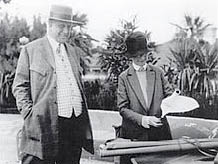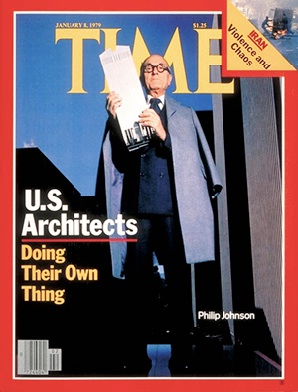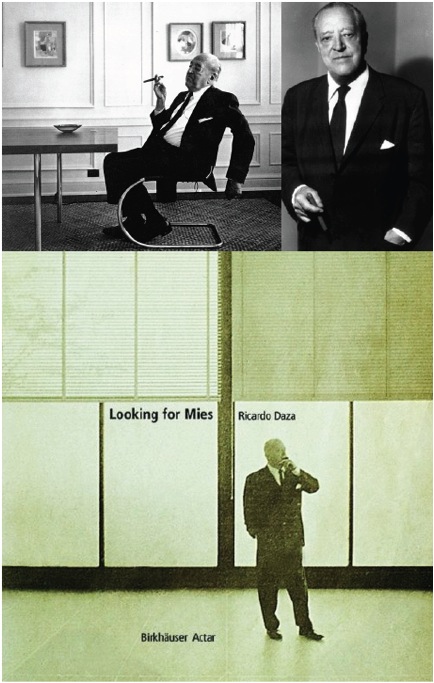Get the Work Get the Work Get the Work
Louis Sullivan’s mantra for the first three rules of architecture, “Get the work, get the work, get the work”(1), underscores the primary importance of securing architectural commissions; for without clients, most architects cannot design to have buildings constructed, for they do not have the necessary financial resources. Little, if anything, is taught in architectural schools about how to obtain architectural commissions. Once one has successfully traversed the arduous route through formal education, internship, and professional exams, one is faced with the problem of how to obtain work if one chooses the path of independent practice. I once asked a principal of a large New York City architectural firm how one should go about obtaining work. He evaded the question with a vague and dismissive response. I assumed that he either did not really know how to obtain work or that he was reluctant to share his trade secrets.(2) After all, in such a competitive business, does one really want to surrender any advantage one might have? The question remains; how does an architect get noticed? How does one meet the right people and earn their confidence to be entrusted with what are relatively costly endeavors?
A perusal of biographies of various notable architectural figures throughout history suggests that there are many ways to develop the relationships, which lead to work. These various paths seem to be a mixture of being in the right place at the right time and rigorous efforts at seeking out and forming the necessary associations that provide opportunities for work.
It seems self-evident that if one is born into a privileged class, that one inherits these associations of fortune. Julia Morgan, the first licensed, woman Californian architect, was from a prosperous Oakland family and never really had to push to find clients; this was enabled by the context of her social background. Morgan’s introduction to William Randolph Hearst led to the commission of Hearst Castle in San Simeon; a property almost a third the size of the State of Rhode Island. Since she found so much work through societal connections, Julia Morgan never needed or attempted to publicize herself or her over 700 designs.(3)
A few other architects of note, Philip C. Johnson and I. M. Pei come to mind, developed their networks and careers through a favored lineage. Johnson had a family inheritance of about one million dollars, equivalent to about 13.5 million dollars in today’s money. This wealth apparently did not include his inherited Alcoa Aluminum stocks, which later multiplied 50 times in value.(4) He expertly used his resources to develop his network of relationships, into a construct of power and influence. For Johnson, the mechanics of self-publicity became a matter of establishing personal connections and creating links between the architectural, artistic and business elite of his time. Johnson's early association with MoMA and his co-authorship of the International Style exhibition and accompanying book, with the historian Henry Russell Hitchcock, served to help launch his career as an architect. Johnson, in turn, used his influence to bolster the careers of the next generation of architects.
I.M. Pei was born into a wealthy Chinese family and was raised in Hong Kong and Shanghai. He pursued an overseas education in the U.S. (something common for Chinese of privilege, in the early 1900s), graduated from Harvard and was later recruited by New York real estate magnate William Zeckendorf. Although opposites in demeanor (Zeckendorf was loud, boisterous and boorish, Pei was quiet, reserved and refined), the two men took and immediate liking to one another. When Zeckendorf discovered that both he and Pei were born in the Year of the Snake, he decided that the fates had thrown them together and that the two of them would set out to redesign the cities of North America. Strangely enough, Chinese astrology also played a part in Pei securing one of his most famous future commissions. Jacqueline Kennedy was not only charmed and impressed by Pei but also had decided to take a leap of faith with Pei since both he and her late husband Jack Kennedy, were born in the same Year of the Snake – 1917.(5)
Despite these examples, many of history’s most influential figures were from relatively modest backgrounds. Frank Lloyd Wright’s family struggled for years as his father was unable to sustain adequate employment as a minister. Louis Kahn was born into a poor Jewish family in Estonia. His family could not afford pencils so they made their own charcoal sticks from burnt twigs, so that Louis could earn a little money from drawings. Norman Foster was born into a working-class family in Manchester. He left school at the age of 16 and drove an ice-cream van to get himself through university. These leading figures rose to success through sheer determination and will power.
Much has been written on the subject of architects' attempts to achieve fame and notoriety but it is not always clear whether these actions are deliberate or sub-conscious efforts. However, the manner in which some architects have insinuated themselves into situations of opportunity can range from the amusing to the bizarre.
One of the earliest accounts of an architect, ingratiating himself in order to gain work is from a description by Vitruvius. Vitruvius tells of how Dinocrates presented a flattering design of a city to Alexander the Great, apparently in a state of semi-undress. He had designed Mount Athos as a colossal likeness or figurative representation of Alexander, to appeal to the king’s ego. Having captured the attention of Alexander, Dinocrates secured a position as his architect.(6) Vitruvius himself dedicated his “De Architectura” to his patron, the emperor Caesar Augustus.
Modeling his publication after that of Vitruvius, Leon Battista Alberti published his “Ten Books of Architecture”, and dedicated it to Pope Julius V. As a papal official and adviser, Alberti’s dedication is only logical since Julius V had aspirations for rebuilding the city of Rome. Also of note, is that Alberti’s treatise contained no illustrations, making it of little use to the builder. The books were originally written in Latin, and were more likely designed to appeal to the learned humanist or potential patron. Alberti had realized that developing a link to patronage would require that the architect strive for a higher social status. Hence, his Ten Books of Architecture was written to inform the humanist patron so that the patron and architect would share the bond of an appreciation for architectural theory.(7)
Most of the distinguished architectural careers in the sixteenth century were built around such patrons. Examples are Bramante and Pope Julius II, and Michelangelo and the Medici family. Continuing along these lines, Andrea Palladio’s “Four Books on Architecture” contained Palladio’s own designs, which inspired numerous patrons and became a very influential reference. United States president Thomas Jefferson was a keen admirer of Palladio and once referred to the Four Books as "the Bible". In a sense, these texts could be considered as early counterparts to the modern day architectural monograph – marketing tools for promoting the knowledge and talents of their authors.
Andrea Di Pietro della Gondola, as he was born in 1508, was renamed Palladio by his mentor, the architect Giangiorgio Trissino. Trissino introduced his apprentice to an ever widening circle of patrons and bestowed upon Andrea a name derived from ‘Pallas Athene’, the Greek goddess of wisdom, to contribute to the reinvention of his protégé’s persona.
The altering of one’s name, and crafting of one’s appearance, has carried on in to the modern era. Instances of architects who altered their names as part of efforts to be identified with a certain social class or to camouflage their association with a derided ethnic population are Le Corbusier, Mies van der Rohe, Louis Kahn, and most recently, Frank Gehry.
Charles-Edouard Jeanneret-Gris (born 1887) did not adopt the pen name Le Corbusier, until 1920, when he founded the magazine L’Esprit Nouveau (using a pseudonym to identify one-self was in vogue by artists in many fields during that era, especially in Paris). Between 1906 and 1914, he travelled and worked throughout Europe - Paris, Vienna, Berlin and later in Greece where he filled nearly 80 sketch books with material (some of which would appear in his landmark book “Vers une Architecture). During this time, most of Corbusier’s independent work was theoretical in nature, and it is this time which may be considered his formative years as a self-taught architect. Jeanneret’s transformation to Le Corbusier, not only reflected his desire to reinvent himself, but also marked the beginning point in his career when many of his best known residential designs were built (the Villa La Roche, Villa Stein-de Monzie, and the Villa Savoye were all constructed during the 1920’s).
Maria Ludwig Michael Mies donned the nobler sounding Ludwig Mies van der Rohe as part of his rapid transformation from a tradesman's son to an architect working with Berlin's cultural elite, despite his lack of formal education. He added "van der" and his mother's surname "Rohe" (using the Dutch "van der", rather than the German form "von" which was legally restricted to those of genuine aristocratic lineage), to counter the German connotation of Mies, which meant “bad” or “rotten”. He married Adele Auguste Bruhn, the daughter of a wealthy industrialist which allowed him to focus all of his energies on his career through lean periods.(8) Mies was not interested in politics except in cases where political associations might lead to the acquisition of architectural commissions. His connection to the Nazi party was a serious lapse in judgment, however, one that he was willing to let pass in order to pursue his obsessive search for work.(9) Mies was famous for his impeccably tailored dark suits and trademark cigar. As pointed out by the architectural historian Beatriz Colomina, photography was crucial in Mies van der Rohe’s exploitation of the media to fabricate his image as an avant-garde architect.(10) Below are some of the more publicized images of Mies.
Louis Kahn was born Itze-Leib Schmuilowsky. His father changed their surname to Kahn nine years after they immigrated to the States. No doubt, those of modest origins felt that their fortunes would improve if they did not have to contend with the growing anti-Semitic tides of the early 20th century. Kahn received his architectural degree from the University of Pennsylvania in 1924. In 1947 he became a visiting critic at Yale and met the architectural historian and critic, Vincent Scully. Scully became Kahn’s most ardent advocate, and together they forged one of the most mutually beneficial alliances between architect and critic. Scully championed Kahn as the right architect for the addition to the Yale Art Gallery, which was Kahn’s first important commission. However, Kahn never mastered the appearance of effortlessness which other more polished architects like Gropius and Mies used to conceal their labors.(11)
Kahn carried burn scars from a childhood accident which disfigured his face, that together with his personal awkwardness and mannered speech, unnerved potential clients like Robert and Jacqueline Kennedy who passed Kahn over for the commission of the JFK presidential library, in favor of I.M. Pei. Described as an ‘ugly little man’ in his son’s 2001 posthumous biopic “My Architect”, Kahn’s physical shortcomings were more than compensated for by his charismatic intellect. His appearance did not appear to hinder his amorous pursuits either, as he was married, yet carried on two long-term affairs, fathering offspring from each of these relationships. While his career blossomed in the last 20 years of his life (Kahn did not gain notoriety until he was in his 50’s), producing such late-modern masterworks as the Salk Institute, the Exeter Academy Library, and the Kimbell Art Museum, Khan died in a men’s restroom in New York’s Penn Station, almost half a million dollars in debt. Pei praised Kahn by conceding that his own, although more extensive oeuvre, did not compare to the significance of Kahn’s canonical works.
Frank Owen Goldberg became Frank Gehry, in part to disguise his Jewish background but also because of his first wife’s wishes. He later regretted this change, somehow sensing that it was disingenuous, much like how he was feeling at that time, about his satisfactory but not very provocative commercial practice doing shopping centers. Perceiving himself to be at a standstill in his professional and personal life, Frank Gehry felt financially and emotionally bankrupt. Then, in the late 1970’s, although well into his 50’s, he abandoned his commercial architectural practice, left his family, and reinvented himself as an avant-garde architect. His association with painters and sculptors informed the next phase of his career, which pushed the limits of architectural form and produced some of the most startling and acclaimed structures of the late 20th and early 21st century.(12)
Gehry quickly became one of the leading architects of his era. Philip Johnson extolled Gehry’s 1997 Bilbao Guggenheim Museum by stating that he was moved to tears upon experiencing the space. Then in 2005, Gehry became a household name when he appeared as a Simpsons cartoon character. The show, however, gently lampooned the formal characteristics of his architecture when it mockingly suggested that he derived inspiration for his architectural forms from a crumpled piece of paper.
Perhaps the most well-known American architect to take advantage of periodic reinvention is Frank Lloyd Wright. Wright deserted a thriving residential architecture practice in Oak Park Illinois and left his wife and five children to run off to Europe with the wife of one of his clients. This much publicized scandal may not have been the rash, impulsive decision that is popularly believed. Research by one of Wright’s biographers indicates that Wright put his affairs in order before leaving, suggesting that his departure was a calculated move.(13) It has also been conjectured that Wright, having reached a peak in residential design, felt that he could go no further with his current practice and felt that a break with his past would be necessary in order to take his career to the next level, which would provide opportunities for larger commissions.
Although it may seem as if these observations verge on parlor trivia, they are actually part of an attempt to examine the nature of the various relationships that had a seminal role in shaping the careers of some of history’s most important architectural figures. It is also interesting to note the importance which some architects place on how the public perceives them. However, this is not surprising since it is believed that architectural firms must proactively engage in publicity and marketing in order to establish ties to corporations, local governments, and other privileged groups and classes, so as to assure themselves an ongoing practice. Yet, for the beginning architect, the conundrum remains; “to gain experience, you need commissions but without experience, you don’t get commissions”.
posted by Edward Jose
Notes:
(1) As quoted to me in my freshman year of architecture school, by Professor Mark A. McBurney, 1985.
(2) Seminar at the NYC office of Perkins Eastman, circa 2005.
(3) Julia Morgan, Architect by Sara Holmes Boutelle, 1988.
(4) The Philip Johnson Tapes, Interviews by Robert A.M. Stern, 2008.
(5) I. M. Pei, Architect of Time, Place, and Purpose by Jill Rubalcaba, 2011.
(6) “Functional Icons, Charles Jencks in Conversation with Norman Foster.” Fame and Architecture, Architectural Design Volume 71- No. 6, November 2001.
(7) The Architect, Chapters in the History of the Profession - chapters 4 & 5. Edited by Spiro Kostof, 1977.
(8) Mies van der Rohe: A Critical Biography by Franz Schulze, 1995.
(9) Architects of Fortune: Mies Van Der Rohe and the Third Reich by Elaine S. Hochman, 1989.
(10) “Goodness Greatness: The Images of Mies Once Again”. Famous, Perspecta 37, 2005.
(11) Makers of Modern Architecture by Martin Filler, 2007.
(12) Sketches of Frank Gehry, Documentary Film directed by Sydney Pollack, 2006.
(13) The Prarie School, Frank Lloyd Wright and His Midwest Contemporaries, by H. Allen Brooks, 1972.












